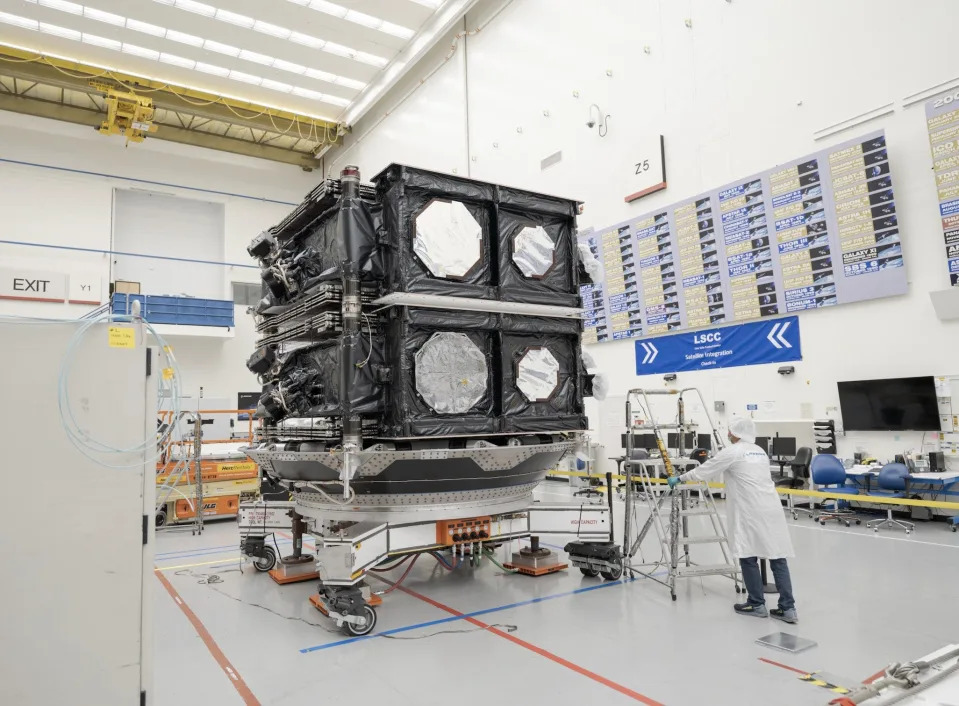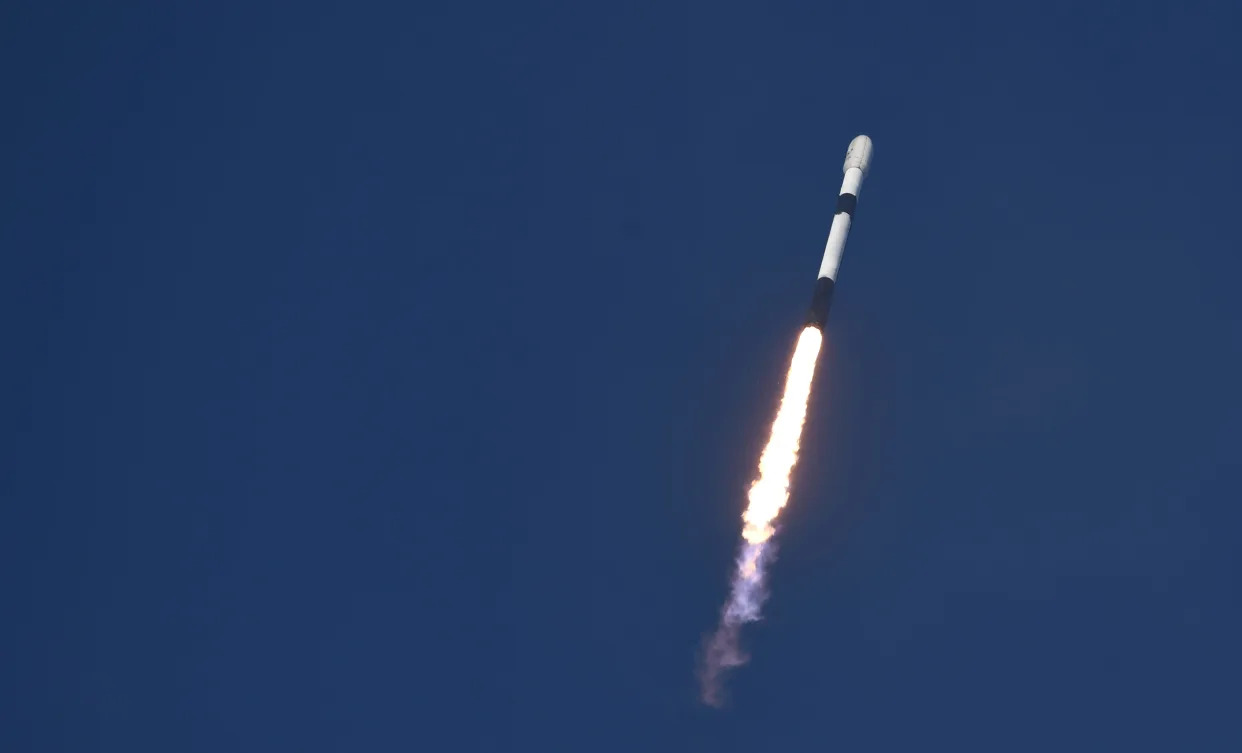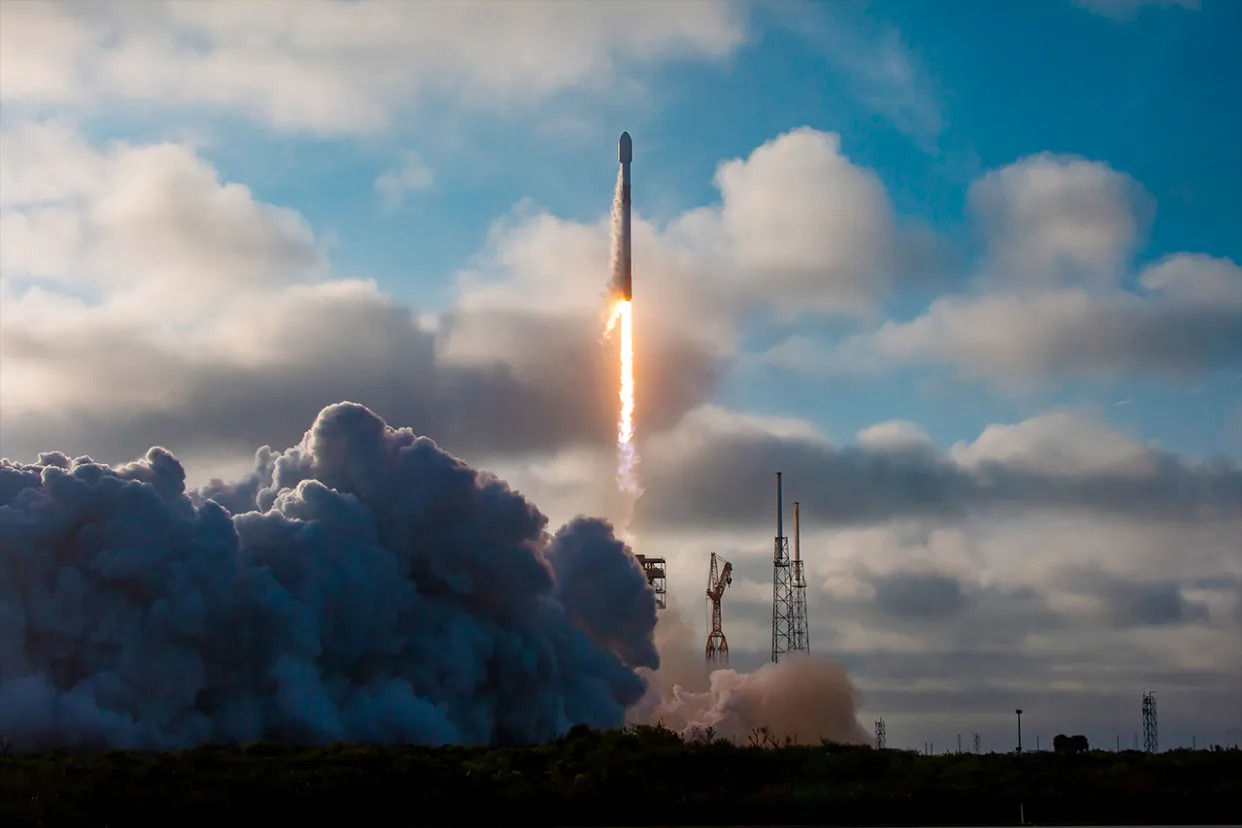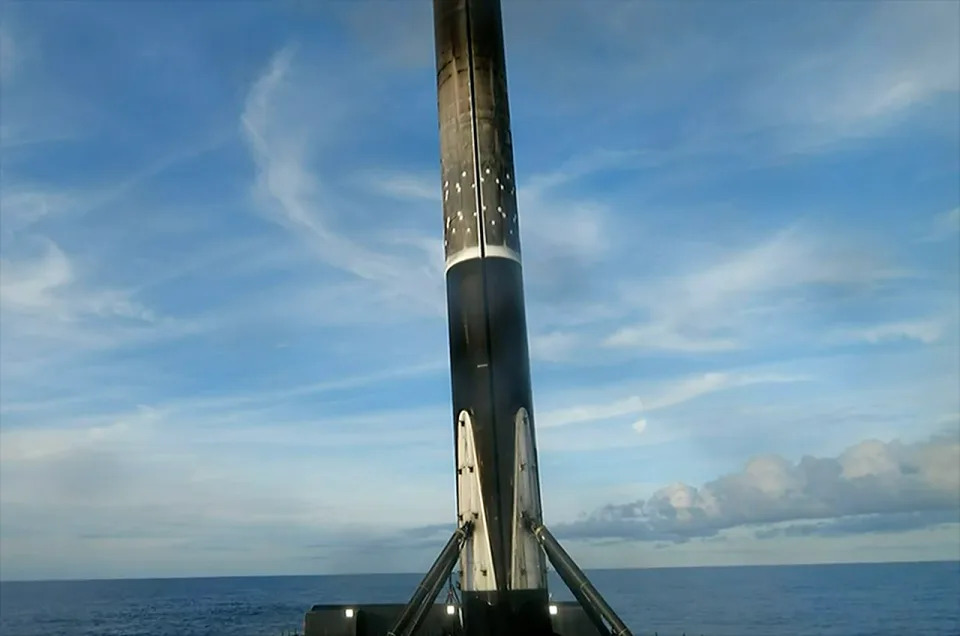James Tutten
Sun, November 12, 2023
SpaceX successfully launched its Falcon 9 rocket carrying communication satellites in the SES O3b mPOWER mission.
SpaceX is set to launch another Falcon 9 rocket from Florida’s Space Coast on Sunday.
The rocket is set to launch at 4:08 p.m. from the Cape Canaveral Space Force Station.
This mission aims to send broadband communication satellites into orbit for a foreign internet company.
Watch: SpaceX and NASA looking to launch prototype Starship, awaits second test flight
SpaceX said this launch will be the ninth flight of the rocket’s first-stage booster, which previously launched CRS-26, OneWeb Launch 16, Intelsat IS-40e, and five Starlink missions.
Following the launch, SpaceX is planning to land the first stage of the rocket on its A Shortfall of Gravitas droneship in the Atlantic Ocean.
SpaceX Falcon-9 rocket launches with telecommunications satellites aboard
Amy R. Connolly
Sun, November 12, 2023

A SpaceX Falcon 9 rocket launches 22 Starlink satellites on mission "6-23" at 8:39 PM from Launch Complex 40 at the Cape Canaveral Space Force Station, Florida on Oct. 17. File Photo by Joe Marino/UPI
Nov. 12 (UPI) -- SpaceX launched its Falcon 9 rocket successfully Sunday afternoon carrying communication satellites for a Luxembourg-based internet company.
The Falcon 9 rocket lifted off at 4:08 p.m. from Launch Complex 40 at Cape Canaveral Space Force Station on Florida's east coast, taking Boeing-built O3b mPOWER satellites to medium-Earth orbit for SES.
About 8-1/2 minutes after lift-off, Falcon 9's first-stage booster landed aboard a barge, known as "A Shortfall of Gravitas," in the Atlantic Ocean. The mission marked the ninth flight of the first-stage boosters, which previously launched CRS-26, Starlink and others. The rocket's upper stage will not be recovered, which is normal for Falcon 9 flights, Space.com reported.

Time exposure of the SpaceX Falcon 9 rocket as it launches Starlink satellites on mission "6-25" from Launch Complex 40 at 7:20 PM from the Cape Canaveral Space Force Station, Florida on Oct. 30. Photo by Joe Marino/UPI

The SpaceX Falcon 9 rocket launches 21 Starlink satellites at 10:47 PM on mission 6-12 from Launch Complex 39 at the Kennedy Space Center, Florida on Sept. 3. This was the 62nd orbital launch for SpaceX in 2023, breaking last year's total of 61. Photo by Joe Marino/UPI
SpaceX knocks out Sunday launch while targeting 2nd try for massive Starship this week
Richard Tribou, Orlando Sentinel
Updated Sun, November 12, 2023

Orlando Sentinel/TNS
SpaceX added to the Space Coast’s growing tally of launches for the year with a Sunday night liftoff while gearing up potentially for another attempt of sending its new Starship and Super Heavy rocket up on an orbital test flight later this week.
A Falcon 9 launched from Cape Canaveral Space Force Base’s Space Launch Complex 40 at 4:08 p.m., sending up a pair of satellites for Luxembourg-based SES.
This is the third time SpaceX has sent up a pair of SES’s O3b mPOWER satellites, which are headed for medium-Earth orbit. They are part of SES’s goal of sending up 11 such satellites to increase connectivity to remote places.
The “O3b” is in reference to the “other 3 billion” referring to the Earth’s population without access to the infrastructure found in more metropolitan areas. The mPOWER satellites are the next generation of an existing constellation of MEO satellites for SES already used by companies such as Princess Cruises.
This was the ninth flight for the first-stage booster, which landed downrange in the Atlantic on the droneship A Shortfall of Gravitas.
It marked the 63rd rocket launch in 2023 on the Space Coast, with SpaceX flying all but four of those. SpaceX has also flown 24 missions from California for the year, and has now had 83 successful orbital launches for the year.
In April, it attempted to fly to orbit its Starship and Super Heavy from its Boca Chica, Texas site Starbase for the first time, but problems with stage separation before reaching orbital altitude forced SpaceX to have the rocket self destruct over the Gulf of Mexico.
SpaceX still awaits final approval to fly from the Federal Aviation Administration, but its second attempt for the orbital test flight has a target to launch on Friday, according to the company’s website.
SpaceX will stream the test about 30 minutes before liftoff.
“As is the case with all developmental testing, the schedule is dynamic and likely to change,” the company stated.
Starship is the replacement rocket for SpaceX’s Falcon 9 and Falcon Heavy, and despite not making it to orbit, became the most powerful rocket to make it off the launch pad with more than 17 million pounds of thrust at liftoff during the April 20 attempt.
If it makes it orbit on this second attempt, it would surpass the record-holding power generated by NASA’s Space Launch System during its November 2022 launch on the Artemis I mission, which topped 8.8. million pounds of thrust.
“There are really a tremendous number of changes between the last Starship flight and this one, well over 1,000,” Musk said in a June interview. “I think the probability of this next flight working, you know getting to orbit, is much higher than the last one.”
Plans for this attempt still look to have Starship to climb to between 93 and 155 miles during a trip that will take it two-thirds of the way around the Earth for a hard splashdown near Hawaii.
The April attempt saw the rocket, using a combined propellant of liquid methane and liquid oxygen, make it through what’s called Max Q, the area where the craft endures maximum dynamic pressure, and it did achieve speeds up to 1,340 mph.
Had all gone well, both the booster and Starship were to have separated and each made their own hard water landings, with the booster splashing down in the Gulf of Mexico and Starship in the Pacific Ocean after its flight.
The launch system in Texas, and one that will eventually be built at Kennedy Space Center, is designed so that eventually the Super Heavy booster would return to the 469-foot-tall launch integration tower often referred to as “Mechazilla,” with a landing achieved with the aid of two pivoting metal arms called the “chopsticks.”
The Starship spacecraft would make a vertical landing at its destination as well, which would make the combination the first fully reusable rocket in the industry.
NASA has been waiting on SpaceX’s Starship as it has contracted with Musk’s company to provide a working version for its astronauts in the Artemis program to use it as their ride down to the surface of the moon.
That mission is currently slotted for the Artemis III flight, no earlier than December 2025, but that would require for SpaceX to get its Starship up and running and perform a successful uncrewed landing on the moon before NASA would let its astronauts on board.
For SpaceX, plans are to fly dozens if not more than 100 operational launches of Starship before it lets any humans on board, but it has at least three commercial human spaceflight missions already lined up in addition to the NASA mission.
Updates: SpaceX SES O3b mPOWER mission from Cape Canaveral Space Force Station in Florida
Rick Neale, Florida Today
Updated Sun, November 12, 2023
Updates: Following is live coverage of Sunday's 4:08 p.m. EST liftoff of a SpaceX Falcon 9 rocket on the SES O3b mPOWER 5 and 6 mission from Cape Canaveral Space Force Station in Florida.
Welcome to FLORIDA TODAY's Space Team live coverage of SpaceX's Falcon 9 launch this afternoon from Cape Canaveral Space Force Station.
SpaceX is targeting an 89-minute window from 4:08 to 5:37 p.m. EST to launch a rocket carrying a pair of communications satellites from Launch Complex 40 at Cape Canaveral Space Force Station.
The Falcon 9 is flying under contract with SES, a Luxembourg-based company that will place two more of its Boeing-built O3b mPOWER satellites into medium-Earth orbit.
After soaring skyward from Launch Complex 40, the Falcon 9's first-stage booster will target landing aboard a drone ship out at sea 8 minutes, 43 seconds after liftoff. No local sonic booms are expected during today's mission.
Countdown Timer
SpaceX Falcon 9 booster lands
Update 4:16 p.m. EST: The Falcon 9 first-stage booster just landed aboard SpaceX's drone ship A Shortfall of Gravitas out on the Atlantic Ocean, wrapping up its ninth flight.
Liftoff!
Update 4:08 p.m. EST: SpaceX has launched a Falcon 9 rocket carrying a pair of SES O3b mPOWER satellites from Launch Complex 40 at Cape Canaveral Space Force Station.
Next, the first-stage booster should land on a SpaceX drone ship out on the Atlantic Ocean.
SpaceX live launch webcast underway
Update 4:02 p.m. EST: SpaceX's live launch webcast hosted on X (formerly Twitter) is now posted at the top of this page.
Liftoff is scheduled in six minutes from Cape Canaveral Space Force Station.
SpaceX Falcon 9 fueling underway
Update 3:59 p.m. EST: Nine minutes before today's 4:08 p.m. launch window opens, visual cues indicate Falcon 9 fueling procedures are well underway.
That means today's SES O3b mPOWER mission is now committed to lift off today, or else the launch must be postponed.
SpaceX booster to land on drone ship
Update 3:47 p.m. EST: Tonight's mission marks the ninth flight for this Falcon 9 first-stage booster, SpaceX reports.
Following stage separation, the booster is slated to land on the drone ship A Shortfall of Gravitas out on the Atlantic Ocean 8 minutes, 43 seconds after liftoff.
SpaceX Falcon 9 launch countdown
Update 3:22 p.m. EST: Following is a list of key milestones in the upcoming Falcon 9 countdown timeline:
35 minutes: Rocket-grade kerosene and first-stage liquid oxygen loading begins.
16 minutes: Second-stage liquid oxygen loading begins.
7 minutes: Falcon 9 begins engine chill prior to launch.
1 minute: Command flight computer begins final prelaunch checks; propellant tank pressurization to flight pressure begins.
45 seconds: SpaceX launch director verifies “go” for launch.
3 seconds: Engine controller commands engine ignition sequence to start.
0 seconds: Falcon 9 liftoff.
SpaceX launch weather: overcast skies
Update: 3:11 p.m. EST: Skies above Cape Canaveral Space Force Station are overcast with a temperature of 76 and north wind of 13 mph, the National Weather Service reports.
The Space Force's 45th Weather Squadron previously forecasted a 70% chance of "go" weather for today's launch.
SpaceX to launch SES satellites

The Luxembourg-based satellite company SES released this photo of a technician making preparations alongside O3b mPOWER satellites in advance of SpaceX's Nov. 12 mission launching them into medium-Earth orbit from Cape Canaveral Space Force Station.
Update 2:55 p.m. EST: This morning, SES tweeted a quartet of photos featuring its third pair of O3b mPOWER satellites, which will head into orbit atop the Falcon 9 rocket.
These will mark satellites No. 5 and 6 in the company's planned series of 13 in orbit.
For the latest schedule updates at the Cape, visit floridatoday.com/launchschedule.
321 Launch: Space news you may have missed over the past week (Nov. 14)
Rick Neale, Florida Today
Mon, November 13, 2023

SpaceX launch obscured by clouds Sunday in Central Brevard during SES O3b mPOWER mission
Quickly cloaked by thick cloud cover, as viewed by many Central Brevard spectators, a SpaceX Falcon 9 rocket lifted a pair of communications satellites into medium-Earth orbit Sunday afternoon for the Luxembourg-based company SES.
After the 4:08 p.m. EST launch from Cape Canaveral Space Force Station, the Falcon 9's first-stage booster separated and returned to Earth for a fiery landing aboard the drone ship A Shortfall of Gravitas out at sea.
Read the full story here.
NASA supply mission to ISS launches Thursday night aboard SpaceX Falcon 9 rocket from KSC
Liftoff! A SpaceX Falcon 9 rocket launched from Kennedy Space Center on Thursday night, sending a Dragon cargo capsule on a 32-hour trek to dock with the International Space Station.
NASA's 29th commercial resupply services mission soared into orbit on a northeasterly trajectory at 8:28 p.m. EDT from pad 39A under picture-perfect launch conditions, per the Space Force's 45th Weather Squadron.
Read the full story here.
'Bacteria Boys': Viera students to send experiment on NASA's SpaceX resupply launch to ISS
Scuttling about in the Indian River Lagoon's murky depths, horseshoe crabs — regarded as "living fossils" that predate the dinosaurs — may provide a future biomedical function that helps keep NASA astronauts healthy during marathon missions to Mars and deep space.
The "Bacteria Boys" of Pinecrest Academy Space Coast want to find out. So they're sending horseshoe crab blood up to the International Space Station to study whether it can detect E. coli bacteria in the microgravity of low-Earth orbit.
Read the full story here.
SpaceX Starlink mission launches 5 minutes after midnight, lighting darkened Brevard sky
With SpaceX's newly installed crew access arm for use by future astronauts stationed alongside on a support tower, a Falcon 9 rocket blazed into the post-midnight darkness Wednesday carrying another payload of 23 Starlink satellites into low-Earth orbit.
Next, SpaceX is slated to launch a Thursday night NASA resupply mission — including a horseshoe crab blood experiment devised by the "Bacteria Boys" of Pinecrest Academy Space Coast — to the astronauts aboard the International Space Station.
Read the full story here.
Next launch: SpaceX Starlink 6-28 on Thursday/Friday, Nov. 16/17
Though SpaceX has yet to confirm this mission's existence, a National Geospatial-Intelligence Agency navigational warning indicates a rocket launch window will open late Thursday night:
About: A SpaceX Falcon 9 rocket will launch the company's latest batch of Starlink internet satellites from Cape Canaveral Space Force Station in Florida.
Launch window: 11 p.m. Thursday to 3:31 a.m. Friday EST.
Live coverage: Starts 90 minutes before liftoff at floridatoday.com/space.
For the latest schedule updates, visit floridatoday.com/launchschedule.
Rick Neale is a Space Reporter at FLORIDA TODAY (for more of his stories, click here.) Contact Neale at 321-242-3638 or rneale@floridatoday.com. Twitter/X: @RickNeale1
This article originally appeared on Florida Today: 321 Launch: Space news you may have missed over the past week (Nov. 14)
SpaceX launches O3b mPOWER communication satellites on its 84th mission of 2023
Brett Tingley
Sun, November 12, 2023

A SpaceX Falcon 9 rocket lifts off with two SES O3b mPOWER communication satellites from Cape Canaveral Space Force Station in Florida on Sunday, Nov. 12, 2023.
SpaceX launched the SES O3b mPOWER mission on Sunday (Nov. 12), a flight that placed two communication satellites into medium Earth orbit (MEO).
The Falcon 9 rocket ferrying these satellites lifted off from Cape Canaveral Space Force Station in Florida at 4:08 p.m. EST (2108 GMT).
Related: SpaceX launches its 29th cargo mission to the International Space Station

A SpaceX Falcon 9 rocket's first stage lands on the droneship
The Falcon 9's first stage came back to Earth and made a vertical touchdown on the company's drone ship about 8.5 minutes after liftoff. The ship, known as "A Shortfall of Gravitas," was waiting nearby in the Atlantic Ocean; the rocket's upper stage will not be recovered, as is standard for Falcon 9 flights.
Two hours after liftoff, the rocket's upper stage deployed the first of the two satellites into medium Earth orbit (MEO) some 5,000 miles (8,000 km) above our planet. Seven minutes later, the second satellite was deployed.
Related Stories:
— SpaceX launches 22 Starlink satellites from California
— SpaceX aims to launch 144 missions next year
— Amazon's Kuiper satellite constellation will use these sleek antennas to serve you internet
The two Boeing-built spacecraft that were aboard the flight will expand the O3b constellation of communication satellites operated by provider SES S.A. of Luxembourg. Once the six-satellite constellation is complete, it is expected to provide high-speed connectivity to a variety of customers in both government and private industries beginning in late 2023.
The Falcon 9 booster on the flight flew on eight previous missions, five of which were devoted to building out Starlink, SpaceX's megaconstellation of broadband internet satellites. Starlink currently consists of more than 5,000 operational satellites.
The SES O3b mPOWER mission marked SpaceX's 84th launch of the year.
No comments:
Post a Comment